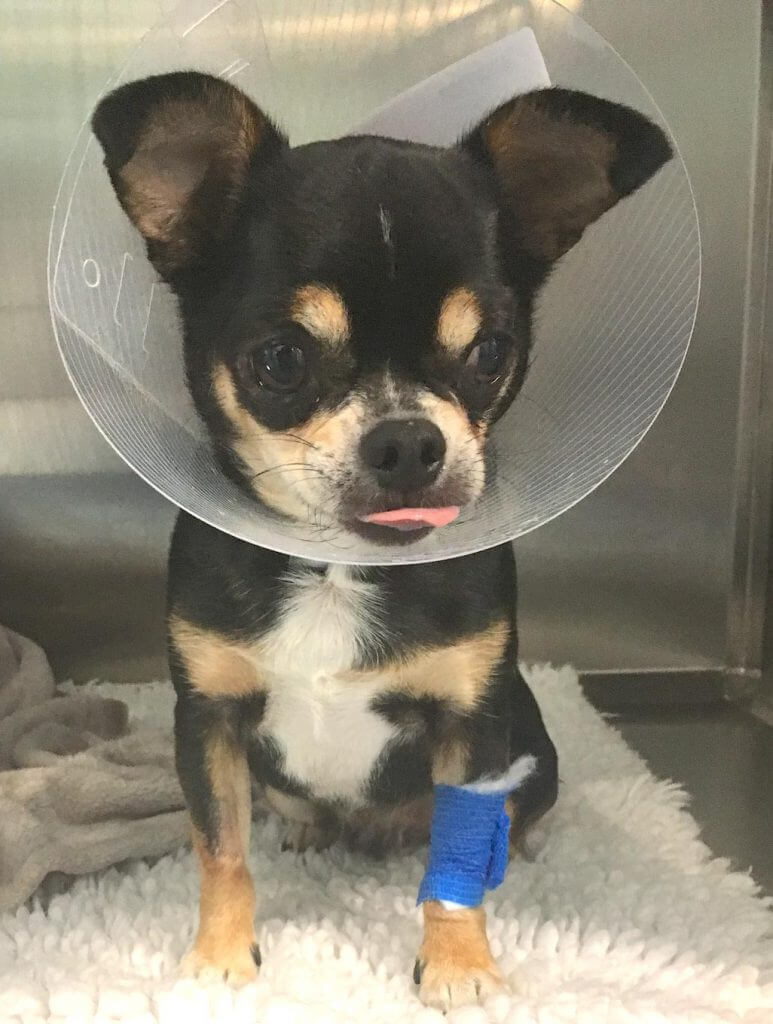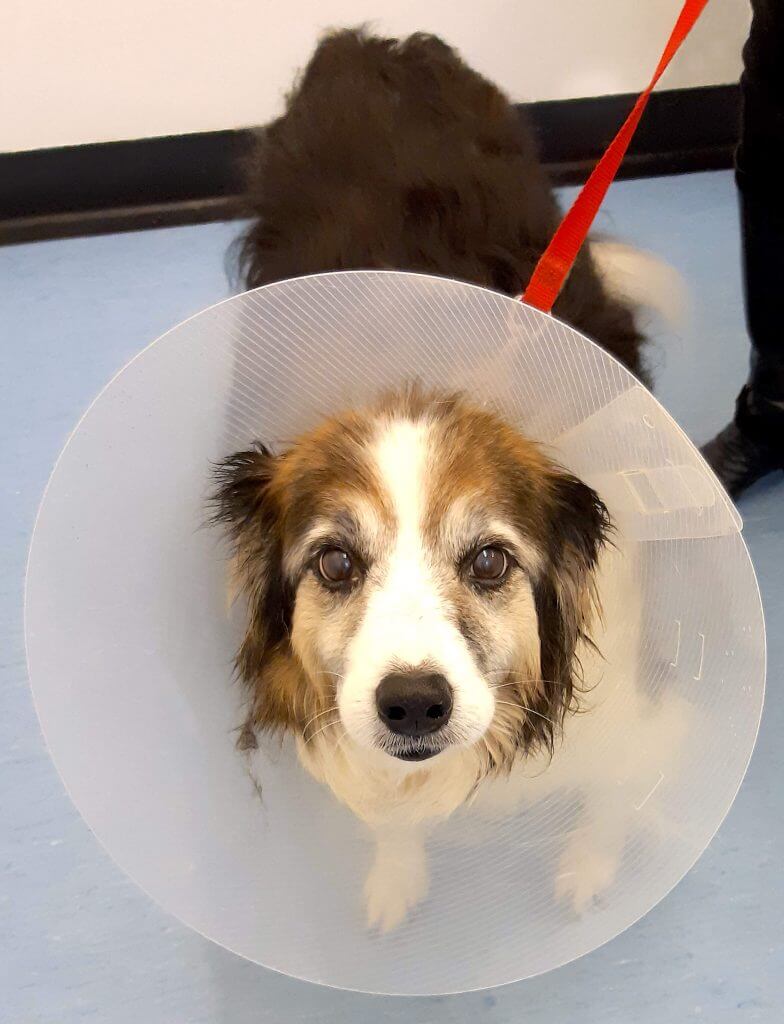What do lumps on dogs mean?
What is a lump and what causes them?
Lumps and growths on dogs come in all shapes, sizes and locations and are common in dogs and cats. Not all lumps are ‘growths’. Sometimes the cause of the swelling may be an abscess, cyst, seroma (fluid-filled swelling sometimes seen after a knock or after surgery), an area of inflammation or callus (thickened skin due to rubbing) etc. An examination will usually be able to determine if this is the case and then appropriate treatment can be provided.
Generally, it is impossible to give a 100% accurate answer as to what a growth is just by examining it, although it may be possible to suggest what it is likely to be, and therefore, depending on the appearance of the lump, your vet may advise on further testing.
Lumps vs tumours
The word ‘tumour’ is a very emotive word and is associated and used often when diagnosing lumps in pets. The word originates from the Latin ‘tumor’ which means ‘swelling’ and therefore technically it could be used for any swelling on the body.
In veterinary, however, we do generally tend to use the word to describe a growth – this could be equally applied to a benign growth (or lump) as much as a malignant (cancerous) growth, therefore if we describe a growth as a tumour, this does not necessarily mean that it is cancerous.
How common are lumps on pets?
Lumps are a very common occurrence on pets and is a good reason for us to examine our pets regularly. There are many types of lumps and growths and while some may be unpleasant for dogs and cats, many are not.
How to treat lumps on pets
If it appears that a lump genuinely appears to be a growth, the next consideration will be to decide on an approach. Options for further investigation may include:
Fine Needle Aspirate (FNA)
Fine needle aspirate involves inserting a needle into the growth to remove some of the cells. These are then transferred onto a microscope slide to allow examination under the microscope (cytology). The advantage of FNA is that it allows investigation of a lump without having to resort to anaesthesia and more invasive techniques.
Often this procedure is done while your pet is with you in the consulting room and it’s usually not painful, meaning it is uncommon for the animal to need sedation or anaesthetic for your vet to carry this out. It may not be appropriate in some cases, particularly if a growth is very close to a sensitive area or if your pet is in pain around the area, and it may also depend on your pet’s temperament.
In a lot of cases, FNA can provide useful information about a growth which will then inform your vet’s next steps, i.e does it need removing, and how big a margin around the lump do they need? The disadvantage is that in a small proportion of cases, the sample may provide no useful information; some lumps may not shed cells very easily and may not provide a representative sample.
How accurate the answer also depends on where the needle passes into within the lump. In some cases, a lump may have a surrounding fatty tissue. If the needle passes into the surrounding tissue rather than the core of the lump this may provide misleading information.
When do you get the results?
Cytology samples are usually reported to your vet within a day or two if sent to an external laboratory. Some samples may be examined by your vet within the surgery.
Surgical biopsy
A surgical biopsy may give a more accurate answer than a FNA. A surgical biopsy allows examination of a section of tissue and the arrangement of the cells within the tissue (histopathology), as opposed to the FNA which provides cells that have been sucked out and are no longer in their normal arrangement.
This may provide more accurate information as to how malignant or benign a mass is. It is a particularly useful technique for certain type of growths which either may not shed cells very easily or when it is important that we know what grade (severity) that the growth is, as this may affect how aggressively we have to treat your pet. The downside to a biopsy is that it usually requires general anaesthesia to retrieve the samples.
How long for surgical biopsy results?
Typically histopathology samples have a slightly longer turnaround in the lab than cytology samples. In most cases, however, the results will be reported back to us within a week or two (depending on the type of sample).
Lumpectomies and Surgical excision (removal)
Removal of any abnormal lumps from your pet’s skin, muscle or connective tissue layer is often referred to as a lumpectomy. This is a surgical procedure, carried out under a general anaesthetic, usually with the intention of full removal of the lump. Fine needle aspirate or biopsy may be performed prior to surgical removal so it is apparent how much tissue needs to be removed from around the growth (margins) to ensure it is completely taken away.
Some benign tumours such as lipomas (fatty lumps) and cysts can grow to a significant size but will not spread or invade nearby tissue. These can be removed with minimal margins. Some more aggressive tumours require larger tissue margins to be taken to reduce the chance of them regrowing or spreading.
The shape of the surgical incision to remove the lump and allow closure without tension or puckering will often mean the resulting surgical wound is larger than the original lump. In areas where there is limited skin to allow closure of the wound, such as the lower legs and face, skin may be advanced from other areas to cover deficits.
The growth is sent to the laboratory for diagnostic testing (histopathology) in most cases. This provides more information about the structure and nature of the mass, plus the margins can be analysed for evidence of invasion into the surrounding tissues.
Recovery is usually within 10-14 days, depending on the size and location of the tumour. Some larger lump removals, or those in certain areas, will require drains to be placed in the wound site to prevent fluid accumulation for the first 3-5 days following surgery. Large or complex wounds may take several weeks to heal fully.
Assessing the reports
When we are assessing cytology and histopathology reports, we are first interested in whether the sample shows that the lump is truly a growth or whether it could be something else such as inflammatory tissue.
Benign or malignant?
The next consideration is whether the growth is benign or malignant. A benign tumour refers to a growth that does not spread and doesn’t invade into the surrounding tissue. These can usually be cured by surgical removal or, if appropriate, may be monitored only.
The term ‘malignant’ describes a growth that is invading into surrounding tissues and that may be expected to spread to other areas of the body (metastasis). This would be generally how we would refer to a ‘cancer’.
Regardless of the result, your vet will discuss any implications with you and talk through the next steps and any further treatment options which may be required.
If your pet develops a growth, we would always advise that it is worth booking a free consultation with your nearest Animal Trust surgery to examine the area of concern.




